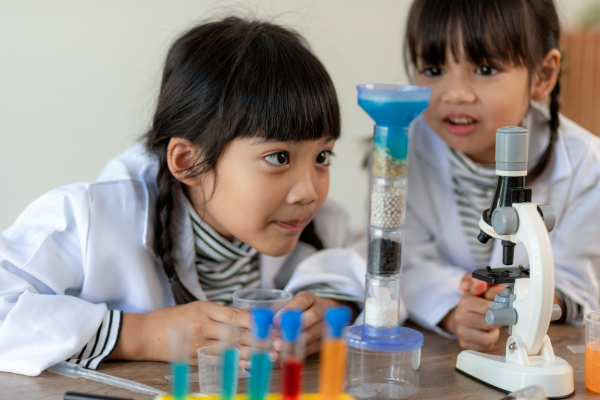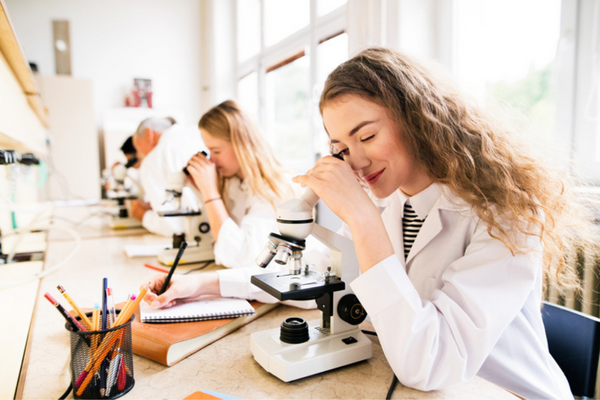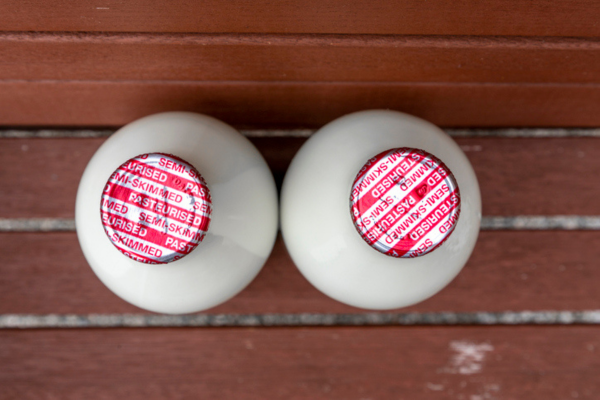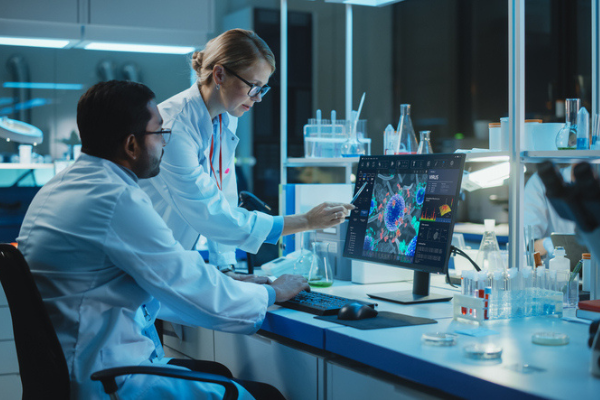
While at Syracuse University, you earned your undergraduate degree in chemistry, and your PhD in organic chemistry, in a total of just six years. That’s pretty unusual. What prompted you to undertake such an arduous task? And what sacrifices did you have to make along the way?
Growing up, there was no question that my parents valued education, and perhaps because both were professionally employed, they encouraged my sister and me to take classes in the summer, if only to have something to do! And since I was a bit younger than most undergrads, getting a summer job wasn’t realistic. So, with a bit of AP credit, summer classes and a regular load of 18 credit hours per semester, it was easy to get my undergrad degree in 3 years.
I had also started to do research as an undergrad and had decided to stay in the same group for grad school. That gave me a head start – I started my grad research the summer before I entered the grad program. Looking back on it, I can’t really say that I had to make sacrifices; I think what helped was being focused and being able to multi-task.
You spent nearly 30 years working at the legendary Bell Labs. What did you learn there that was most helpful in advancing your career?
Bell Labs provided a great environment for anyone interested in science/engineering/technology development! Perhaps the most important things I learned were the value of multidisciplinary approaches to solving problems and even more importantly, the value of diversity in identifying and solving those problems. They also had a culture where both managers (most of whom continued to be engaged in research) and established researchers provided opportunities for younger staff members to engage with the community and demonstrate what they can accomplish.
It’s my managers and mentors who provided opportunities for me to give invited talks at conferences and organize symposia, and they encouraged me to get involved in professional society activities. I feel very fortunate that I was able to connect with the Polymer Materials Science and Engineering Division (PMSE) of the American Chemical Society. Being part of a Division helps to create a sense of having a ‘home away from home’ and of having an extended family.
In a NY Times opinion piece published on February 25, 2012, Jon Gertner wrote the following about Bell Labs: “For a long stretch of the 20th century, it was the most innovative scientific organization in the world.” What can today’s chemical enterprise learn from Bell Labs’ decades of unmatched innovation?
Bell Labs' culture was one that supported collaboration and innovation. If someone had a question, they could just go down the hall and initiate a discussion that frequently led to new experiments with interesting new results. The culture was such that fundamental research was supported, but that research was also conducted in a technology rich environment. The business/technology problems stimulated a lot of exciting new fundamental research directions. Researchers were excited to learn about those opportunities and they were eager to engage with their colleagues to simply ‘solve problems’. Importantly, they were allowed to do what they were passionate about, research. But it really was still research that had a technology focus and that could be connected to the business.
In the July 22, 2002 issue of C&EN, while employed in industry, you wrote the following: “Chemistry is traditionally taught stovepipe-fashion--each discipline walled off and a world unto itself … those involved in technology-related research and development soon learn that the stovepipe structure that shaped our education isn't conducive to developing and disseminating new technologies. We discover that the key to success in that arena is collaboration and cooperation unfettered by traditional roles and disciplines.” Has academia sufficiently adjusted to this reality in the nearly two decades since you made this observation?
There is no question that academia has embraced the value of collaboration and multidisciplinary approaches to research, and many departments encourage collaboration. But we’re still facing challenges. I still hear comments from tenure-track assistant professors saying that their departments don’t encourage collaboration until after tenure. It’s associated with identifying who contributed what to a project/publication – it’s easier if it’s not a collaboration.
The problem is that if you wait until after tenure to engage in collaborations, you’ll have a really steep learning curve. And without collaborations, there are many missed funding opportunities. Agencies today want to fund groups of researchers who truly work together – they don’t want to see the funds simply split between the groups with everyone ‘doing their own thing’. The whole, truly has to be more than just the sum of the parts. But we are getting there, and it’s important to note that not all academic research can or should be collaborative. We need to strive for a balanced mix.
How have your parents influenced your leadership style?
My parents believed in the value of education and hard work. And if I ever had a problem I couldn’t solve on my own, I could always ask them. They wouldn’t solve the problem for me, but they’d offer suggestions and guidance, for me to solve the problem. I think that set the stage for me to try to guide those I work with, but at the same time encourage them to be independent. I also encourage them to develop their own networks to get answers to questions they might have.
Perhaps from my Bell Labs experience, I’m also a strong proponent of an ‘open door’ policy, and everyone around me knows that if my door is open, I’m there and I’ll stop what I’m doing to chat. As long as I’m not traveling, my door is typically open.
First at Bell Labs, then at Georgia Tech, and starting in September - at Lehigh University – the ability for you to successfully lead teams is core to your success. What have you learned about leading teams over your career in industry and academia?
That’s pretty easy to answer! Just give everyone on the team the opportunity to show what they can do and be successful. My role is to be there to support them in achieving their goals!
What technical challenge addressed during your career brought the most satisfaction, and why?
The one technical challenge I’d highlight is being able to work with a team of researchers to develop both the chemistries for a photoresist sensitive to 193 nm radiation and the process that allowed it to be used on a silicon device fabrication line. We were successful because we had a multidisciplinary team of scientists and engineers, along with colleagues from the business arena working on the project, and each brought with them much needed, valuable expertise.
Talk about the metaphorical “one that got away”. Is there a project that eluded you? Why? And if you could return to it, what would you do differently?
This one is a difficult question – there have certainly been things that didn’t work the way I envisioned things, but whether it’s working with peers or students, we’ve generally been able to chart a path to successfully complete a given project. Part of that is to think about how to overcome obstacles, or circumvent them. If an experiment fails, is there a way to turn that into a success – a ‘how do I make lemonade out of lemons’ approach.
The one that maybe did ‘get away’ was a project I started on when I first got to Bell Labs that was related to synthesizing an esoteric heteroaromatic compound. In retrospect, it wasn’t very well thought out, and if I were to do things differently, I’d likely talk to more of my colleagues to explore possible applications and think about alternative structures that might be more interesting.
You served as ACS President in 2003. What should people know about serving as ACS President before they decide to seek the office?
The one thing that stands out about serving as ACS President is that ACS is a great organization with dedicated, creative staff who are committed to helping members be successful. And they’ll be there to help [the ACS President] deliver on important initiatives. It’s a rewarding experience!
What is the one personality trait that has been most instrumental in your career success?
Limiting my response to just one trait is challenging – having an interest in working with people is probably at the top of the list. That coupled with having a strong work ethic.
Nearly 20 years ago, in the September 2001 issue of the Journal of Chemical Education, you wrote about the need to “… to effectively attract and retain underrepresented populations into science and engineering in general, and the chemical sciences in particular. I believe strongly that diversity is a top priority.” How do we make more progress in this area?
We need to truly embrace diversity and we have to create a culture that welcomes and values diversity. As a society, we’re not there yet, and as a discipline we’re not there yet. We need a change in mindset and a change in how we approach education. Every one of us needs to ask ourselves what we should be doing differently. We shouldn’t have students dropping out of Chemistry because a teacher/professor tells them Chemistry is really hard and they should look for something easier. We should be thinking about what we could do to help them be successful, in Chemistry.
You and your husband, Frank Purcell, have four children, including twin boys (now fully grown). For those of us without twins, what was most gratifying - and most challenging - about raising twins?
Twins are really great! Perhaps the most challenging was the sleepless nights in the early days. As much as we tried to have a schedule, they were never hungry at the same time and one of us was up much of the time (and I have to admit that Frank was up with them more than me). The most gratifying was seeing them cooperate to get into something they really wanted. We had a cookie jar behind a kitchen garage, and when they were little, they couldn’t independently raise the garage to get to the cookies. But they figured out that if they worked together, one on each side, they could raise the door! Teamwork and collaboration lead to success!
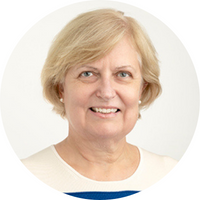
Elsa Reichmanis is Anderson Chair in Chemical Engineering in the Department of Chemical and Biomolecular Engineering at Lehigh University. Prior to joining Lehigh, she was Professor and Pete Silas Chair in Chemical Engineering in the School of Chemical and Biomolecular Engineering at the Georgia Institute of Technology. She started her independent career at Bell Labs where she was Bell Labs Fellow and Director of the Materials Research Department. She received her PhD and BS degrees in chemistry from Syracuse University. Her research interests include the chemistry, properties and application of materials technologies for photonic and electronic applications. She has had impact in the design of new imaging chemistries for advanced lithographic applications, and designed one of the first, readily accessible and manufacturable polymers for advanced silicon device manufacturing using 193 nm lithography.
The Reichmanis research group is currently exploring polymeric and hybrid organic/inorganic materials chemistries for a range of device and electronic and sustainable energy applications. Her research, at the interface of chemical engineering, chemistry, materials science, optics, and electronics, spans from fundamental concept to technology development and implementation, with particular focus on polymeric and nanostructured materials for advanced technologies. Currently, efforts aim to identify fundamental parameters that will enable sub-nanometer scale dimensional control of organic, polymer and/or hybrid materials for applications including transistor devices, photovoltaics and high capacity energy storage.
Elsa Reichmanis was elected to the National Academy of Engineering in 1995 and has participated in several National Research Council (NRC) activities. She was an elected member of the Bureau of the International Union for Pure and Applied Chemistry (IUPAC); and has been active in the American Chemical Society throughout her career, having served as 2003 President of the Society. Elsa Reichmanis is the recipient of several awards, including the ACS Award in the Chemistry of Materials (2018), the ACS Award in Applied Polymer Science (1999), the ASM Engineering Materials Achievement Award (1996), and the Society of Chemical Industry’s Perkin Medal (2001). In other service, she is an Executive Editor of the ACS Journal, Chemistry of Materials.
This article has been edited for length and clarity. The opinions expressed in this article are the author's own and do not necessarily reflect the view of their employer or the American Chemical Society.
Copyright 2020 American Chemical Society (All Rights Reserved)



